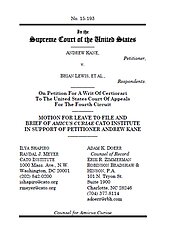Erik Zimmerman and Adam Doerr of Robinson, Bradshaw & Hinson, P.A. worked with Cato on the brief.
Kane v. Lewis
Learn more about Cato’s Amicus Briefs Program.
When a police SWAT team raided Andrew Cornish’s home in Cambridge, Maryland at 4:30am, the officers were heavily armed, dressed in black, wearing helmets and goggles, and carrying battering rams. (They were investigating small-time drug possession—seriously.) They stormed the residence without announcing themselves and killed Cornish seconds later as he emerged from his bedroom in his underwear. Cornish’s estate sued the Cambridge police. At trial, Cornish’s estate claimed that the police violated two Fourth Amendment rules. First, the police violated the knock-and-announce rule when they failed to wait more than five seconds for him to answer the door after knocking. Second, the police violated the prohibition on excessive force when they shot him to death. The jury found for Cornish’s estate on the knock-and-announce violation and against him on the excessive force violation, awarding damages to the estate. On appeal, the Fourth Circuit arrogated to itself the role of the jury—the resolution of questions of fact—and determined that because “the Officers’ illegal entry was not the legal cause of Cornish’s death,” the estate was only entitled to nominal damages to “vindicate the depravation of Cornish’s constitutional rights.” Cornish’s estate has now appealed to the Supreme Court. The knock-and-announce rule is an ancient one rooted in the English common law. In the early 17th century, Lord Coke noted that if a sheriff “break the house when he may enter without breaking it (that is, on request made, or if he may open the door without breaking), he is a trespasser.” That rule continues to this day: “law enforcement officers must announce their presence and provide residents an opportunity to open the door.” Hudson v. Michigan (2006). The knock-and-announce rule serves to protect the life, limb, and property of both home occupants and police serving a search or arrest warrant. Cornish’s estate should thus be entitled to due compensation for the unconstitutional deprivation of his right to life. Indeed, this case is particularly troubling because it represents a growing trend of paramilitary policing in America. The over-deployment of SWAT teams radically enhances the threat of harm to both civilians and officers for what should be ordinary police work. SWAT team deployments have increased more than 1,400% since the 1980s. Between 1980 and 2005, the average annual number of domestic paramilitary raids increased from 3,000 to 50–60,000. SWAT teams and tactical units were originally created to address high-risk situations, such as terrorist attacks and hostage crises. Today, however, these extreme situations account for only a small fraction of SWAT deployments; they’re used primarily to serve low-level drug-search warrants. Kane v. Lewis represents an excellent case for the Supreme Court to send the important message that lower courts should respect the role of juries in our constitutional structure, not contort the law to avoid holding the police accountable. Accordingly, Cato filed an amicus brief supporting the petition for review on behalf of Cornish’s estate and calling for summary reversal of the Fourth Circuit.
